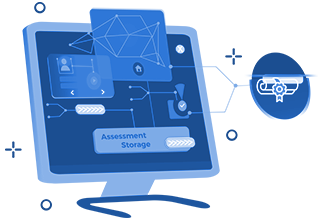1. An overview
In Canada, postsecondary education is the responsibility of provincial and territorial governments, and each jurisdiction has its own quality-assurance mechanisms. There is no national system of education. It is important to note that, in Canada, postsecondary education encompasses all types of formal instructional programs beyond secondary school, including academic, vocational, technical, and continuing professional education, whether offered by universities, colleges, or institutes.
This report describes the quality-assurance mechanisms used in each of Canada's ten provinces and three territories to ensure high-quality postsecondary education. The introduction provides an overview of the approaches taken, and is followed by chapters detailing the practices in each jurisdiction.
For the purposes of this report, the term "quality assurance" refers to the achievement of educational-program standards set by institutions, professional organizations, government, and/or standard-setting bodies established by government. In Canada, the term “accreditation” refers most often to the evaluation of specific university and college programs by professional bodies and, as such, is an important component of quality assurance.
All public and private "recognized" and "authorized" postsecondary institutions in Canada have been given the authority to grant academic credentials by their provincial or territorial governments, through charters or legislation that ensures or enables mechanisms for institutional and program quality. "Registered" or "licensed" institutions are monitored by government for institutional and program quality and consumer protection, depending on the jurisdiction. In some jurisdictions, there are processes for program approval or voluntary accreditation for private colleges. Non-registered and non-licensed institutions are private commercial enterprises whose programs are not monitored.
Given the broad use of some institutional titles, such as college and institute, and of some credentials, such as diplomas and certificates, it is important to understand the status of a specific institution (whether it is recognized/authorized, registered/licensed, or unregulated), as well as the mechanisms that are in place to ensure program quality. The status of specific institutions can be obtained by consulting Canada education data Web site.
2.Legislation
In each of Canada's ten provinces and three territories, legislation is used to some degree by governments to establish, govern, recognize, or ensure the quality of postsecondary educational programming.
For public universities in most provinces, provincial legislation has established the authority of universities to grant degrees and other credentials, to call themselves “universities,” and to govern themselves through a board of governors and, most often, a senate. Each public university is autonomous in academic matters, including the determination of its own quality-assurance policies and procedures. Universities have the power to set academic, admission, and graduation policies and standards, appoint staff, and undertake academic planning. In some provinces, councils or other government-appointed bodies have been established with responsibility for planning and coordinating the development of the postsecondary system, in consultation with the institutions. These bodies, or the minister responsible for postsecondary education, may be responsible for approving new and significantly revised programs.
Private universities and out-of-province institutions are permitted to offer degrees only after their applications have undergone a quality-assessment process undertaken by provincial government authorities, and approved degrees may continue to be monitored. The review may assess both academic rigour and institutional soundness.
The degree of autonomy and responsibility of public colleges and institutes varies considerably across the country. In some jurisdictions, colleges and institutes are largely autonomous, with the government determining which credentials they can grant and/or approving their mandates, while the college boards of governors manage their programs and quality assurance. In others, ministers or appointed external councils have responsibility for establishing guidelines for program evaluation and appointing review teams or for approving all programs and authorizing their delivery.
Private colleges and institutes, which operate under a wide variety of names, are registered or licensed in most jurisdictions. Depending on the jurisdiction, this may imply consumer protection for students, monitoring of the provision of programs, limits on advertising claims, or the imposition of standards for curriculum and instructor qualifications. Colleges may also offer non-registered programs. In some jurisdictions, private colleges that offer language training programs, programs of less than 40 hours duration, programs that cost less than $1,000, or professional development and single-skill training programs, are not registered or monitored.
Apprenticeship training combines workplace training and class instruction. Provincial and territorial legislation governing apprenticeship training may assign the responsibility for quality assurance to a government department, an industry-led agency, and/or trade-specific advisory committees. These groups may establish standards and content for the in-class portion provided by colleges, monitor training quality, and oversee other aspects of quality assurance. Program standards are set using national or provincial occupation standards. The Interprovincial Standards Red Seal Program promotes and facilitates the standardization of provincial and territorial apprenticeship training and certification; it also provides greater employment mobility throughout Canada. A provincial Certificate of Trades Qualification bearing the Red Seal provides training recognition throughout Canada; for employers, it is an assurance of quality training and certification to nationally recognized standards.
3. Affiliation and federation
An affiliation usually involves a specialized institution, college, or private university and a public university; the affiliation may imply the granting of joint degrees, degree equivalency, or the awarding of the degree through the public university. Federated institutions are administratively and financially autonomous, but academically integrated with degrees granted by universities. In all these cases, quality assurance is the responsibility of the institutions involved in the relationship.
4. External and internal review
External review procedures for universities may involve program-accreditation or -recognition visits conducted by external committees of quality assessors, usually composed of academic peers from outside institutions or representatives from relevant professions. The findings of external reviews are usually reported to an accrediting body, government institution, or professional organization. For colleges and institutes, the external review, where implemented, is usually conducted by a government-appointed council.
Most institutions also use self-assessment methods to conduct internal reviews of the quality of specific programs and of their institutions as a whole. Public colleges and institutes may also involve program advisory committees made up of industry representatives. Programs may be reviewed on a regular cycle, and some institutions have implemented continuous improvement processes. The results of such internal reviews are often provided to government and may be considered in determining eligibility for direct (for example, grants) or indirect (for example, government-based student-loan revenues) public funding.
5.Professional accreditation
At the provincial and national levels, Canadian professional-regulatory bodies (for example, in the fields of nursing, architecture, and engineering) participate in the establishment and review of postsecondary curriculum standards and consult on other issues governing student preparations for entry into professions. Accreditation reviews are conducted through analysis of reports and on-site visits.
6.Other organizations related to quality assurance
There are a number of organizations in Canada that promote quality and the use of high academic standards in postsecondary programs.
The Universities Canada (formerly AUCC) does not have an accreditation role, but membership in Universities Canada, held in conjunction with a provincial charter, may be seen as indicating that a university offers quality education. A university or degree-granting college is admitted to Universities Canada if it meets several requirements related to governance, mission statements, programs, policies, and other factors. External peer review is used to determine an institution's eligibility for membership in Universities Canada. In addition, Universities Canada member institutions have endorsed a statement of principles on institutional quality assurance in Canadian higher education. These principles include having policies and processes in place that apply to the full range of current and planned programs. The quality-assessment process must involve internal and external disciplinary experts, as well as students, faculty, and administrative personnel. Alumni and community representatives may also be involved. The process guidelines and results are to be made available to the public.
The Colleges and Institutes Canada (CIC) is another important national organization that supports the maintenance of high-quality programming in colleges. The ACCC requires member institutions to deliver postsecondary programs of the academic standard for diploma and certificate qualifications as set out by the appropriate jurisdictional authorities, to operate as an integral part of a provincial or territorial government's educational activities, and to be funded primarily through that government.
The Association of Accrediting Agencies of Canada (AAAC) is a national organization composed of professional associations involved in promoting good practices by its members in the accreditation of educational programs.
7.Issues in quality assurance
Quality assurance in postsecondary education is becoming increasingly important in the new educational environment that encompasses a growing international trade in educational services, the expansion of the number and types of institutions offering degrees and other programs in Canada, the increased mobility of students and graduates, and the need for students, parents, governments, educational institutions, and international partners to better understand education in Canada. International agreements, such as theNorth American Free Trade Agreement the UNESCO/OECD Guidelines for Quality Provision in Cross-Border Higher Education, the UNESCO/Council of Europe Convention on the Recognition of Qualifications Concerning Higher Education in the European Region (known as the Lisbon Recognition Convention), and those of the University Mobility in Asia and the Pacific (UMAP) organization, specifically address accreditation, recognition, and the need for improvements in student mobility; they are also creating pressures and sharpening the focus on the importance of quality-assurance procedures.
The Council of Ministers of Education, Canada (CAED) issued the Canadian Degree Qualifications Framework, which describes degree categories and sets out degree-level standards, in addition to statements of procedures and standards for assessing new degree programs and new degree-granting institutions. This framework provides a context for identifying how degree credentials compare in level and standard among jurisdictions, with a view to facilitating continuous improvement, the education and training of an internationally competitive workforce, and international recognition of the quality of Canadian credentials.
 English
English Français
Français 日本語
日本語 中文
中文 한국어
한국어 Русский
Русский










